AMABHUNGANE
The collapse of old king coal, Part Two: How unrealistic targets created an energy crisis
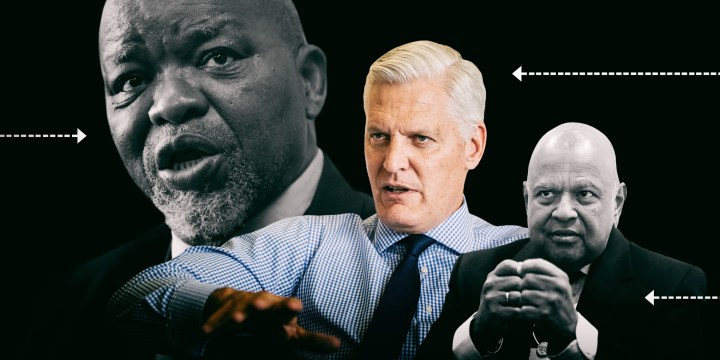
How a toxic mix of politics and optimism led us into the current energy crisis, and why we risk repeating a disastrous history.
It is said that history repeats itself – first as tragedy, then as farce.
On Friday, public enterprises minister Pravin Gordhan announced the new board of Eskom, and issued it a clear instruction: get the availability of Eskom’s power plants back up to 75%.
The energy availability factor (EAF) is the percentage of time a power plant is available to produce electricity. Both breakdowns and maintenance have reduced the current EAF to 58%, resulting in a record-breaking streak of load shedding in September.
Gordhan’s 75% target is not new – it is the number in government’s shareholder compact with Eskom and the number that underpins our current outdated energy plan.
“If you look at it today, the actual performance is below 60%. Below 60% is just not good enough,” Gordhan said on Friday. “And so the board has to ask the question: the journey from 60% to beyond 75%, what does that involve? What extraordinary things need to be done?”
But the 75% target is part of the reason for today’s energy crisis.
The source of the current crisis is the steady decline of Eskom’s once mighty coal fleet. Forced to keep running without proper maintenance, the coal-fired stations are now, on average, only available to produce electricity 55% of the time.
In 2018, Eskom told government it could get the EAF back up to 75% by 2023.
“I think privately many engineers in Eskom were shaking their heads at this,” Eskom’s new chief executive André De Ruyter told us in July.
“This was the answer that government wanted, and therefore that was the answer that government got.”
Even as the coal fleet collapsed and Eskom sounded the alarm that the lofty targets may not be met, government clung to the belief that Eskom could restore its power plants to 75% availability.
The result is that the country now has a 6GW shortfall – a scenario that was not just predictable, but predicted by people inside and outside Eskom.
Instead of learning from past mistakes, government seems determined to repeat them. Asked, on Friday, if the 75% EAF target was still realistic or whether it was being pursued for political reasons, Gordhan said:
“This is not about any political instruction, this is about what the country needs. And if the country needs [75%]… and if experts tell me and others that it is possible to get there, then every effort must be made in an honest endeavour to reach as close to 75%… as is possible.”
This is part 2 of amaBhungane’s series on the collapse of the Eskom coal fleet: a story about how we got it wrong, how we ignored what was happening at coal power stations, clung to unrealistic projections, and walked into an energy crisis of our own making.
- Catch up on Part One: The collapse of old king coal
Crystal ball
Back in October 2016, Eskom’s energy planning office had been asked to make its annual prediction about where the Energy Availability Factor (EAF) would go over the next five years.
The Medium-Term System Adequacy Outlook is supposed to act as an early warning system, identifying any risks to electricity supply that could emerge in the next five years so that adequate plans can be made.
The 2016 report delivered three scenarios: two were based on aspirational targets set by Eskom and government and predicted the EAF would rebound to 80% and 78% respectively. Only one – the least optimistic at 71% by 2021 – was based on Eskom’s own statistical modelling.
But when the next system outlook report was published in October 2017, it only contained one scenario: it confidently predicted the generation fleet would “[recover] to 80% as early as 2020”.
A memo to Eskom’s board indicates that the optimistic 80% EAF projection had come from Eskom’s generation division, under the leadership of Matshela Koko, and was “based on Eskom Shareholder compact [with government] and Eskom Corporate Plan target”, and not on Eskom’s own modelling.
This was a risk: these system outlook reports are supposed to offer a sober assessment, so that plans could be made to cater for the worst-case scenario.
Eskom was now only catering for one possibility: restoring the Eskom fleet to its former glory and an EAF of 80%.
Eskom culture
Koko, who resigned from Eskom in February 2018, still believes this target was realistic.
“We were going to achieve it, our trend was going there,” he said when we spoke to him recently.
Asked whether it was reckless for Eskom to plan for the future based only on aspirational projections, he said: “What is a projection? Your projection is your target. That’s the Eskom management culture… This is what we aspire [to]… and it becomes our target, and you plan for it and you achieve it.”
But Eskom has not achieved it. Instead of an 80% EAF by 2020, as the 2017 system outlook had predicted, the Eskom fleet achieved an EAF of 65% in 2020, leaving a gaping role in the country’s electricity supply.
“I think… there’s certainly a culture [in Eskom],” Brad Ross-Jones, the chief physicist in Eskom’s generation division, told us in December last year, “… and I’m sure it’s in all businesses – that you have managers who need to drive performance, they need to improve… they’re saying ‘we can turn this around, we will do this’.
“And maybe sometimes we confuse target-setting to drive performance with planning, and sometimes you get into trouble if you set aspirational targets because you want to [inspire] people to get them to perform better… but then you still need to plan on what’s more realistic.”
By October 2018, with Eskom under new management, the energy planning office was being more cautious: With the current EAF of 73% the system was “adequate”, the 2018 system outlook report concluded, but if the EAF dropped to 71% – a realistic possibility – the country would be at risk of load shedding.
By October 2019, the outlook was even more sobering: the EAF was now at 68% and the system could face a 5GW shortfall by 2022 if that number continued to decline, a draft of the 2019 system outlook report warned.
This was an astonishing about-turn: in two years, Eskom had gone from predicting an 8GW surplus by 2022 to a 5GW shortfall. Instead of an 80% EAF, the energy planning office now considered 74% to be a best-case scenario, but warned that we could be staring down the barrel of a 64% EAF by 2022 – or worse.
“Insufficient plant maintenance due to either funding constraints or the unavailability of space to do maintenance would cause a further deterioration in plant performance,” it warned.
Visit Daily Maverick’s home page for more news, analysis and investigations
The number government wanted
This should have set off alarm bells at the department of mineral resources and energy (DMRE), which is responsible for the country’s energy planning. Instead, that same month, energy minister Gwede Mantashe signed the long-delayed 2019 Integrated Resource Plan (IRP), which would act as the country’s energy roadmap and guide energy planning until 2030.
In 2018, Eskom had offered the DMRE two possible scenarios: a more ambitious trajectory that saw the EAF recovering to 80%, and a more modest one at 75%. The DMRE sensibly chose the latter.
But by October 2019, even that was looking increasingly ambitious. And whereas 75% had once been a conservative estimate, it was now Eskom’s best-case scenario.
It was not just the DMRE that was guilty of blind optimism. In November 2019, the department of public enterprises, under Gordhan, published an even more ambitious roadmap for Eskom’s recovery that envisioned the EAF rising back up to 77% within 18 months.
Planning for half the crisis
The DMRE was, in fact, acutely aware that its energy plan for the country hinged on what EAF number Eskom could achieve: “The current and future performance of these Eskom plants is critical for security of supply and heavily influences the capacity planned… under the IRP,” it wrote.
Even if the rosy assumption of 75% materialised, the system would still face a 2 – 3GW shortfall over the next three years: “[D]ue to the low EAF of Eskom’s generation plants and the early shutdown of non-performing units… there is an immediate risk of huge power shortages,” the IRP warned.
But the IRP was banking on this crisis being short-lived: as the EAF recovered to 75% and new capacity was added to the grid, the 3GW shortfall would, in theory, disappear.
Eskom had been over-promising and under-delivering on the EAF for years. With each system outlook report, the projections dropped again. And instead of recovering, the coal fleet – which still made up the vast majority of our generating capacity – continued to decline.
As soon as the 2019 IRP was gazetted, alarm bells sounded. Government’s Council for Scientific and Industrial Research (CSIR), which had been actively involved in developing the plan, warned that it was “very likely” that Eskom would not meet the 75% EAF target.
“This is a crisis,” a January 2020 CSIR report stated bluntly. The CSIR’s models showed that using a more realistic EAF forecast of 65% could lead to recurring Stage 6 until 2025.
The DMRE’s Independent Power Producer office would issue a tender to procure 2GW of emergency power to plug the already identified short-term gap. The majority of the contracts would be awarded to three gas-fired Karpowership projects, but these would stall amidst corruption claims, environmental risks and exorbitant natural gas prices.
As for the much bigger problem posed by the failing coal fleet, the DMRE failed to act.
An obstructive ideology?
We asked energy minister Gwede Mantashe why he had not done more when it became apparent that Eskom’s projections about the coal fleet would not materialise.
The DMRE provided a written response on his behalf where it repeatedly shifted the blame to Eskom for providing inaccurate EAF projections: “The Department relied on data provided by Eskom… The Department doesn’t make any assumptions on EAF except placing reliance on Eskom provided information.”
It was – and is – the DMRE’s job to ensure that the country has adequate energy. For this reason, the Integrated Resource Plan is meant to be updated every two years and ministerial determinations issued which give the green light for new capacity to be procured.
The IRP even made provision for this, saying if the EAF continued to decline, the minister had the option of “accelerating” the rollout of the renewables, coal, nuclear and gas that was planned over the next decade.
But under Mantashe, the department’s statist ideology has resisted a greater role for private sector power producers. Take, for example, Mantashe’s reluctance to raise the threshold for embedded generation to 100MW, which would allow companies to produce power for their own consumption. Mantashe eventually agreed, but only with Ramaphosa “twisting my arm”, he said.
Mantashe gave the department the green light to procure new capacity in September 2020, but only what was already planned in the IRP.
Meridian Economics, an independent energy research group, published a report earlier this year showing how the current energy crisis could have largely been avoided if the Renewable Energy Independent Power Producer (REIPP) programme, which stalled in 2016, had been allowed to continue.
“[T]he results are startling – an additional [5GW] of wind and solar capacity… would have allowed Eskom to eliminate 96.5% of load shedding in 2021,” the report concluded.
The DMRE would eventually restart the REIPP programme, issuing a tender for 1.9GW of wind and solar in 2021 and 2.6GW in 2022, in line with the now badly outdated IRP. We asked Mantashe, with the benefit of hindsight, what he would have done differently over the past four years to tackle the energy crisis:
“Ensure that IRP 2019 is strictly implemented,” he said.
He added, in what appeared to be a thinly veiled criticism of the department of environment – which denied Karpowership a permit to operate – that he would also ensure that “procurement is not delayed by other organs of State and ensure everyone is working towards resolving the same problem”.
New management
By 2020, Eskom was under new management. And with André de Ruyter, an experienced private sector leader, as the new chief executive, there was renewed optimism that Eskom could be turned around, even if it meant sacrificing the EAF in the short-term.
As Brad Ross-Jones, Eskom’s chief physicist, explained: “[A]s soon as there was any hint of load shedding… there’s a phone call [to say] ‘do more’. “And what changed in 2020… was that André came in and said, ‘Listen, we can’t do this anymore. We have to take more risk on the load shedding to be able to do more of the reliability or philosophy maintenance’.”
“It’s quite a battle to force people to speak up and to do so without fear of repercussions,” De Ruyter told us in July, recalling that when he first arrived at Eskom the system operator – the unit tasked with maintaining the stability of the grid – was nervous to load shed without the CEO’s permission.
“You’ve got to let the technocrats make the technical decisions. I think that’s what happens when you expect technocrats to deliver politically expedient decisions; you don’t get technically sustainable solutions.”
The Reliability Maintenance Recovery Programme, announced in early 2020, would tackle the backlog of proactive maintenance that is required for a coal-fired power station to reach its full 50-year lifespan.
“I believe Eskom needs to be bold,” chief operations officer Jan Oberholzer told Engineering News at the time. “If it’s time for a… general overhaul, or a midlife refurbishment, or routine maintenance, we take the unit off and we maintain it properly.”
This was how Eskom had treated the Koeberg nuclear plant. “We need to show the same level of respect to the coal units,” he said.
The programme would take at least 18 months to show results, while taking more units down for maintenance would mean accepting a lower EAF and an increased risk of load shedding.
In December 2020, planned maintenance hit a five-year high of 18%, while load shedding broke 2015’s record, hitting 859 hours for the year.
The bottom line
Sticking to a maintenance regime sounds easy, until you have had to obsess about Eskom’s bottom line. A preliminary inspection of a single unit of a power station costs in the region of R15-million, according to Eskom’s 2018 capex budget; a general outage on a single unit: R300-million.
Tutuka power station has six units, and when a maintenance cycle finishes with the last unit, it starts again – an unrelenting drain on Eskom’s dwindling budget.
But measuring maintenance through what is called the Planned Capacity Loss Factor (PCLF) only indicates how much time a unit of a power station was offline, and not the quality of the maintenance: a unit that is offline for 10 days and gets minimal work done will have the same PCLF as a unit that gets through its whole work order in 10 days.
As Eskom’s budget woes bit harder, the generation division could sometimes do little more than the bare minimum: “[T]he reality is that to plan a big outage… when you go in and do intrusive work… the planning window up to that is 24 months,” Paula Goatley, who heads Eskom’s Reliability Maintenance Programme, told us in December 2021.
If a station gets to T minus six months without the money being in Eskom’s bank account, a logistical equivalent of all hell breaks loose.
“We must do the bare minimum work otherwise you cannot run the unit, because we have very stringent safety regulations,” Goatley explained. “Then we have to go back and say, ‘well, power station X, I gave you all the money to do all the work, but I need to actually grab some back to give to power station Y to do the bare minimum so I can keep them on the grid’.”
For Goatley, these unavoidable trade-offs are hard to stomach: “[Y]ou are forever playing this balancing act… because of the funding dilemma and because of the safety criteria… you might be forced to take the unit off knowing full well that you’’re not 100% ready.”
“What happens then? Often we do the absolute minimum,” Logan Reddy – in charge of plant long-term planning at Eskom – told us. “If you’re not ready for that outage, you have to shut it down and do that absolute minimum to keep it compliant.”
Philosophy meets reality
In October 2021, Oberholzer reported that the Reliability Maintenance programme was making progress but it would take another year to bear fruit.
“[I]f you skip one year of [reliability] maintenance… there’s a perception that you can catch it up in a year… not true,” Goatley told us two months later. “It can take you anything up to three years to catch up.”
“[Also] there’s a difference between… proactive maintenance – which is properly planned – and corrective maintenance, which means it’s caught you and the price [can be] double… if not even more… because now you’re playing catch-up and you’re at the mercy of the supplier.”
A significant complicating factor, which we do not deal with in this story, is Eskom’s long-running battle to secure cost-reflective tariffs from the energy regulator.
- “Effectively … we never got the tariffs that we told the country or told the regulator that we needed,” Reddy told us in Part One: The collapse of old king coal
By 2021, Eskom not only needed money, it needed breathing space.
Since his appointment in 2020, De Ruyter had been appealing to government – and specifically to the DMRE – to secure additional electricity from independent power producers. This would allow Eskom to take a unit offline and do in-depth maintenance without the risk of the unit being called back at short notice.
But by November 2021, the country had racked up a new record of 1,136 hours of load shedding and the system was sometimes too constrained for more than the bare minimum.
Speaking to us a month later, Reddy put it bluntly: “[W]e are running outages on now what is the statutory limits… if a piece of high-pressure pipework fails, you quite literally will kill someone that’s anywhere within 30 [to] 40 metres of that failure.”
Eskom, Reddy explained, will take a unit offline when the risk of this kind of failure becomes acute. But this approach leaves little room for reliability maintenance that will see the EAF improve.
The example Reddy gave was driving with your tyres on the legal limit of 1mm tread depth: “You don’t have enough time and money to… go and put [on] brand new tyres. So, you just go replace it with one that’s maybe 2mm… You’re not driving reliability anymore. You’re not putting on the brand-new tyres – which is optimal performance to drive through all the conditions…”
Similarly at Eskom, “you are just keeping yourself legal from an engineering perspective”.
Eskom’s new leadership had initially predicted that increased maintenance would restore the EAF to 70% by December 2021. Instead, the EAF reached an all-time low of 58%.
Have we failed?
“I don’t think that [the Reliability Maintenance Programme] can be said to be a failure,” De Ruyter said.
“But I do concede that it has not delivered according to the expectations that we initially had. And [one] of the reasons for that – and I’ll take accountability for this and say, ‘I got it wrong’ – is I’d anticipated that it would be far easier to deploy resources and to appoint contractors… And that took a lot longer than I’d certainly anticipated, perhaps naïvely coming in from the private sector.”
De Ruyter is convinced that Eskom can no longer both comply with our public sector procurement laws and keep the lights on.
“The challenge with the principle underpinning the [Public Finance Management Act] is that… you need to go and test the market… when you require a skill, it’s a little bit like advertising for a surgeon to conduct open heart surgery – you put an ad in the classified saying, ‘Willing surgeons wanted to come and perform open heart surgery’ and you take the lowest of three quotes.”
De Ruyter said he had “not anticipated the degree of neglect” he would find when he joined Eskom, even amongst the so-called star performers in the fleet, like Lethabo power station which currently has an EAF of 73% and looks good on paper.
Reddy offered his own explanation for Eskom’s crisis: “Inertia,” he told us. With large and complex power utilities like Eskom, “you have to control that”. Once you start deviating from best practices, it becomes a mammoth task to halt the decline.
The numbers bear this out: even as planned maintenance has held steady at 10%, breakdowns have risen exponentially. Whereas 10% planned maintenance was once considered the gold standard, this is seemingly no longer enough to rein in a fleet that is racing towards decay.
“[You’re] saying ‘how do we get to this?’” Reddy said. Money, system adequacy, maintenance – “all of these are different threads… all contributed in their own way to the deteriorated performance.”
The question we should be asking, Reddy told us, is not ‘why are we performing so badly?’ but ‘guys, how can you actually… be performing even at this level?”
… then as farce
In August, after a visit to Tutuka power station – where breakdowns have exceeded EAF for almost three years – Ramaphosa finally broke the glass and declared an energy emergency.
“I think when he saw what Tutuka looked like, he understood that the Potemkin village that had been portrayed to him – a very pleasing picture was presented, you know, ‘Sure, we can get to an EAF 75%’ – but when he saw what the true state of the plant was, then I think he said ‘okay, now we need some drastic interventions’,” De Ruyter told us a few days later.
- Catch up on Part One: The collapse of old king coal
Under the new plan, announced by Ramaphosa, government will procure 15GW of renewables and 3GW of gas as fast as possible, bringing forward virtually all of the capacity planned until 2030 in the IRP.
But the plan also contains a second, painfully familiar strategy – “improving the performance of Eskom’s existing power stations”.
“This isn’t going back to the past and keeping the lights on,” Gordhan said on Friday, in response to questions from sceptical journalists.
Although optimistic, he sees a 75% EAF as a “stretch target”, designed to motivate better performance.
“There’s no point in having targets that have no stretch in them. Ask any business person and they’ll tell you that you don’t set the minimum target and say ‘produce that’ to your staff… In the world I come from, you’ve got to raise the bar, but in a reasonable way.
“And with the right kind of efforts, we are told, we can get [to 75%] over a period of time. The question is how much time and how much damage do you want to do by not having the stretch targets in place?”
Another question we should be asking is whether we are about to make the same mistakes again and walk even deeper into an energy crisis? DM
amaBhungane is a nonprofit centre for investigative journalism. We co-publish our investigations, which are free to access, to news sites like Daily Maverick. For more, visit us on www.amaB.org.
Part Three of this series coming soon.

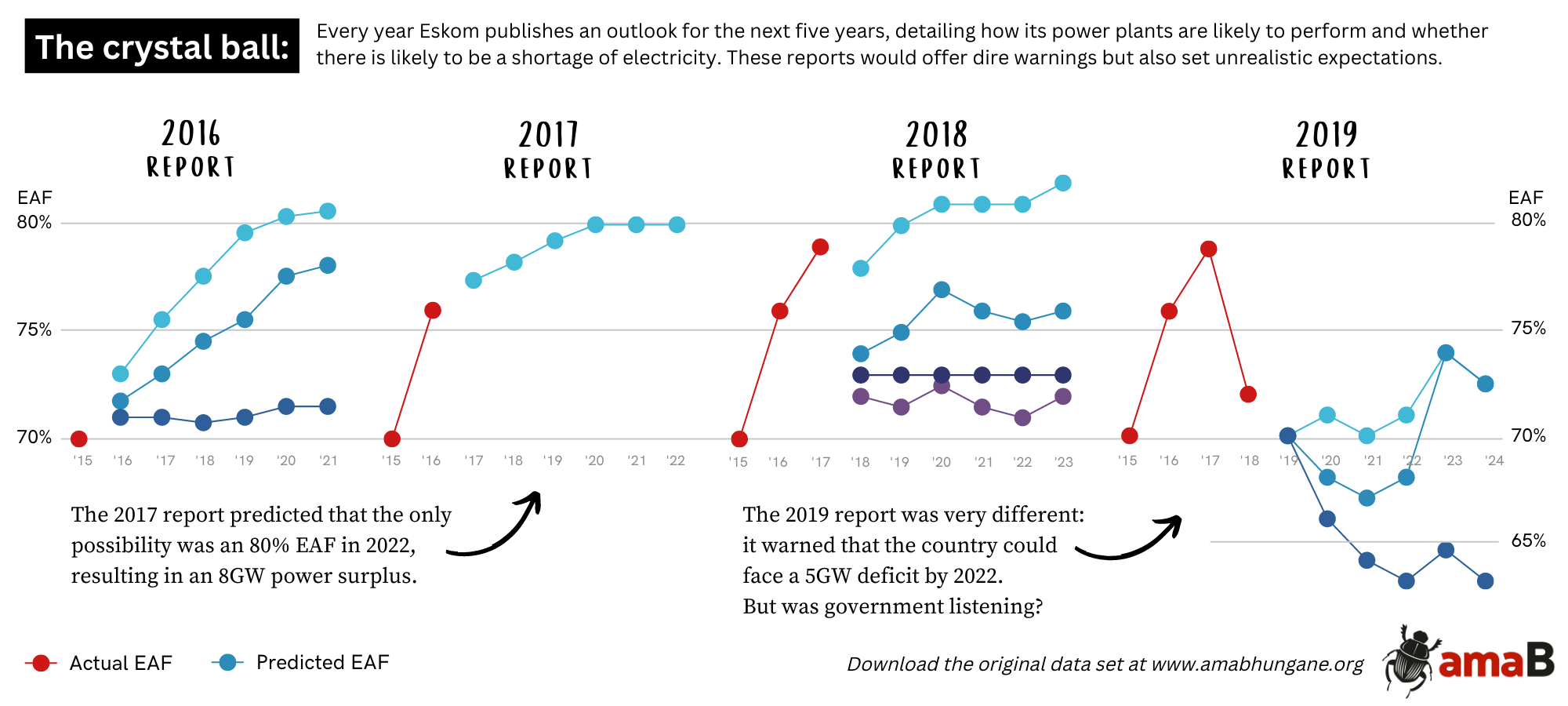
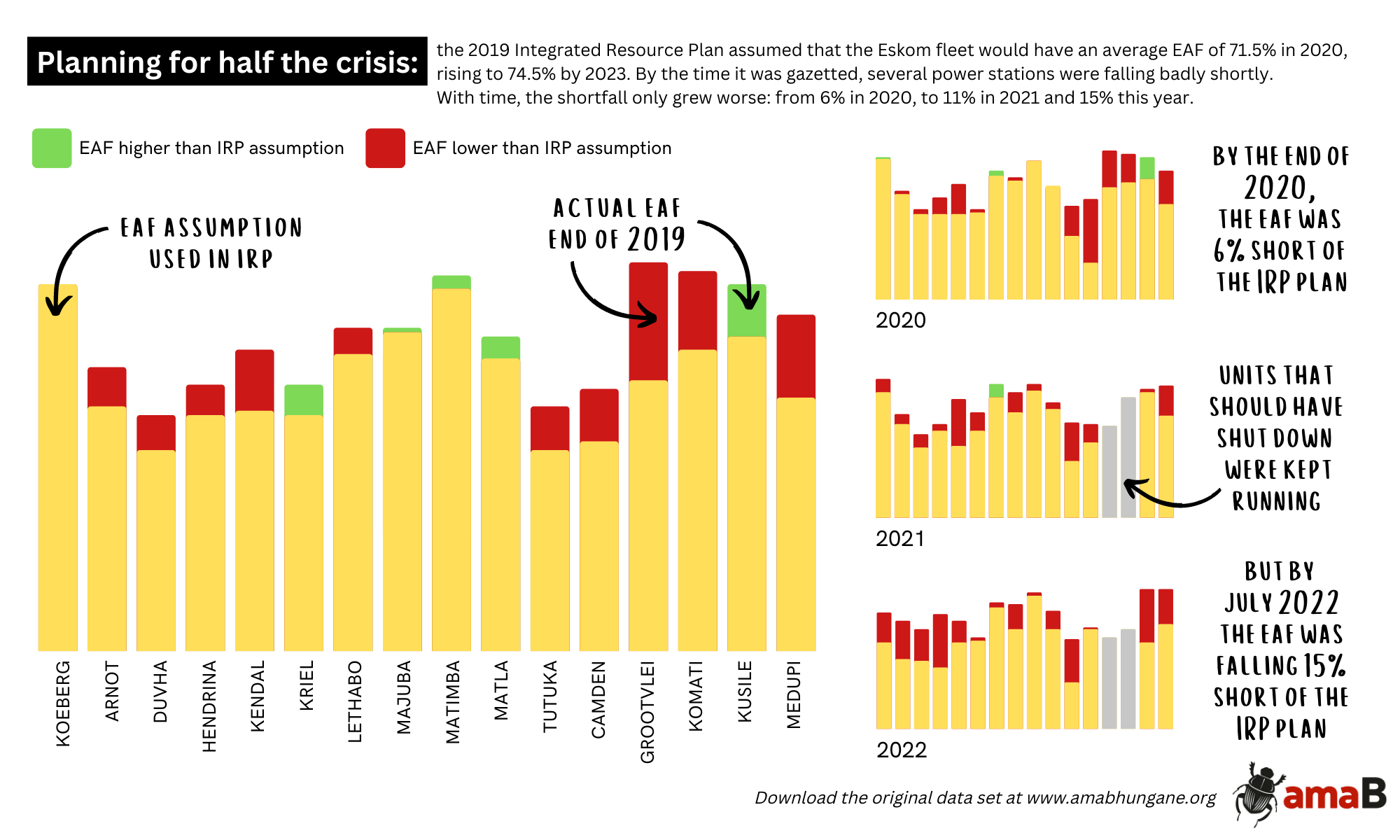
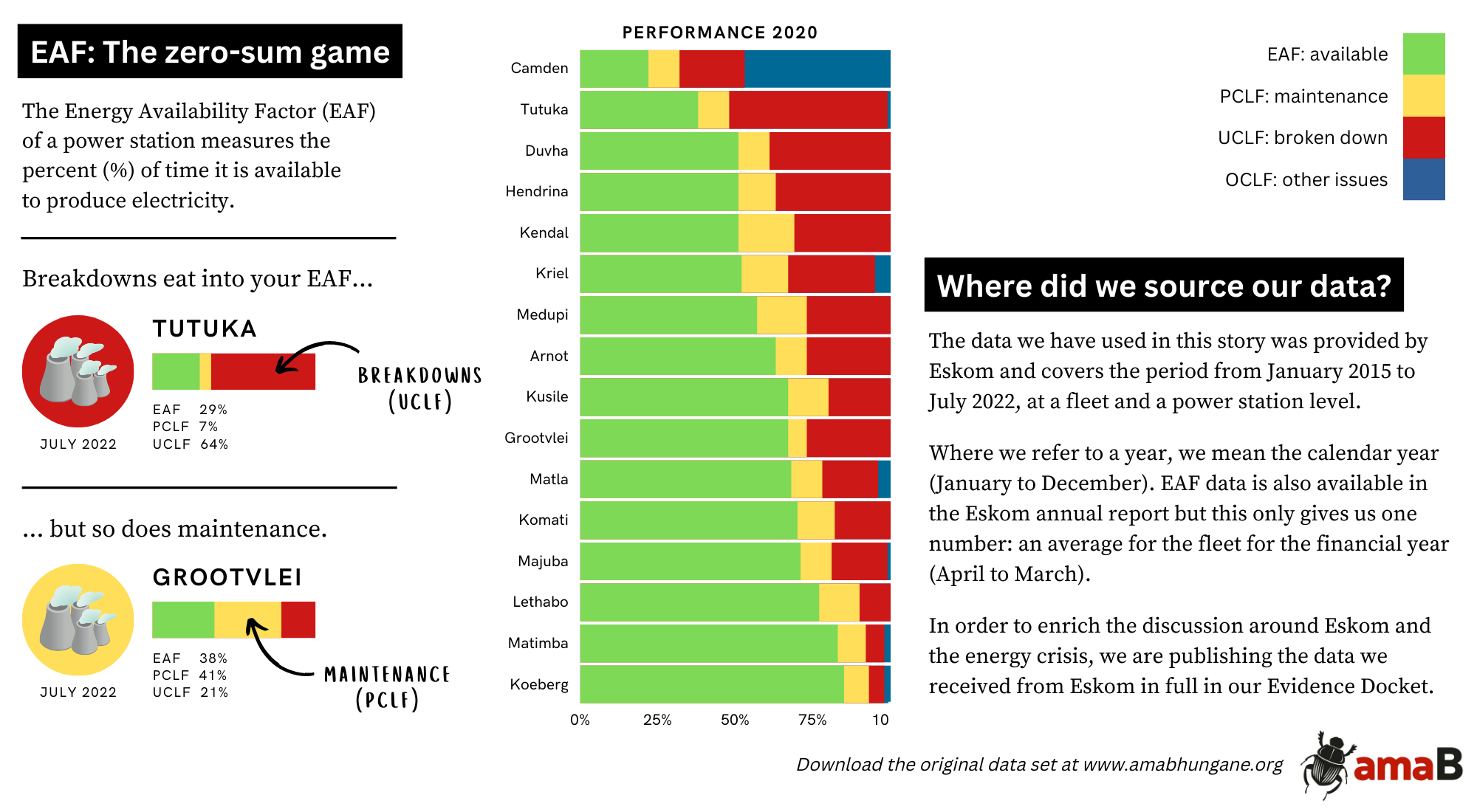
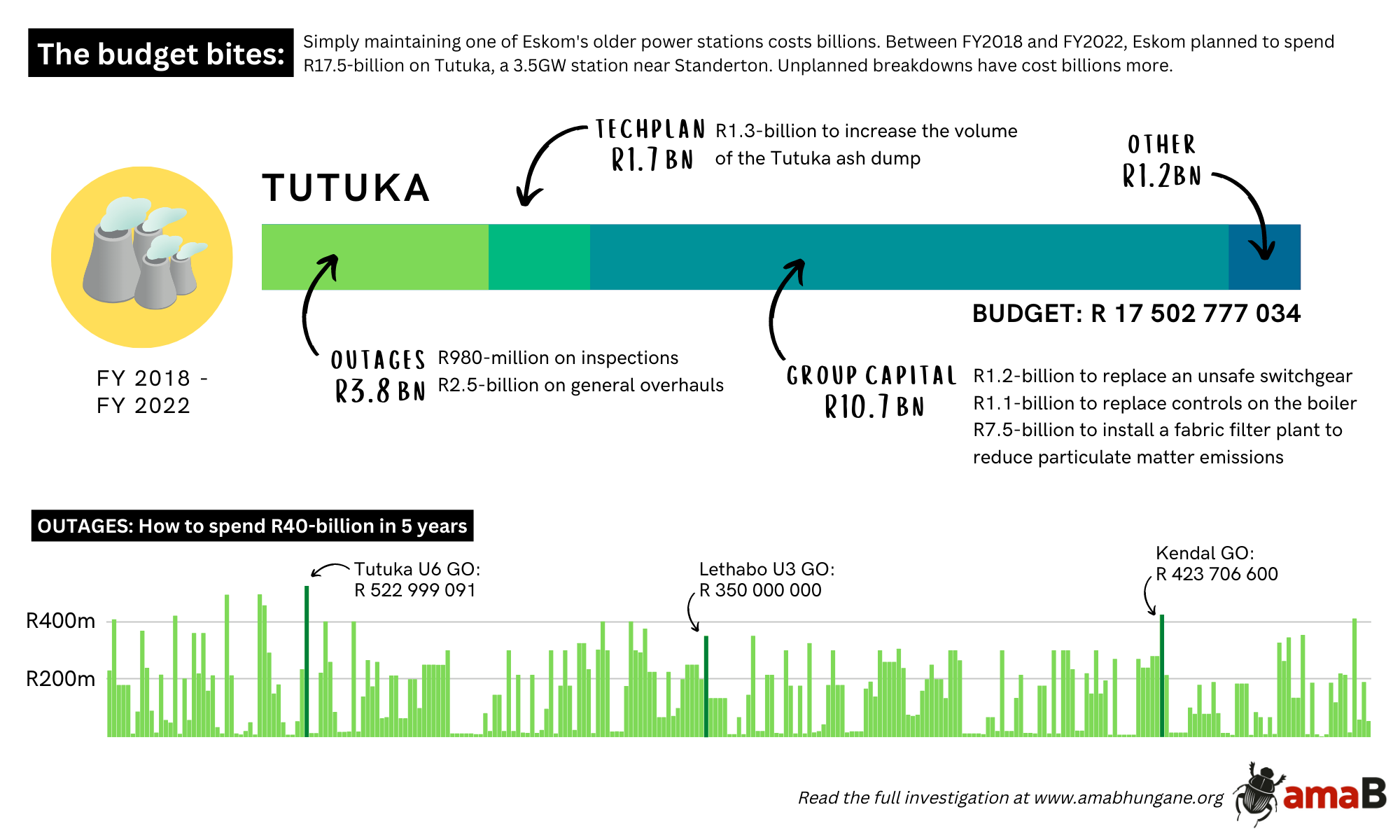
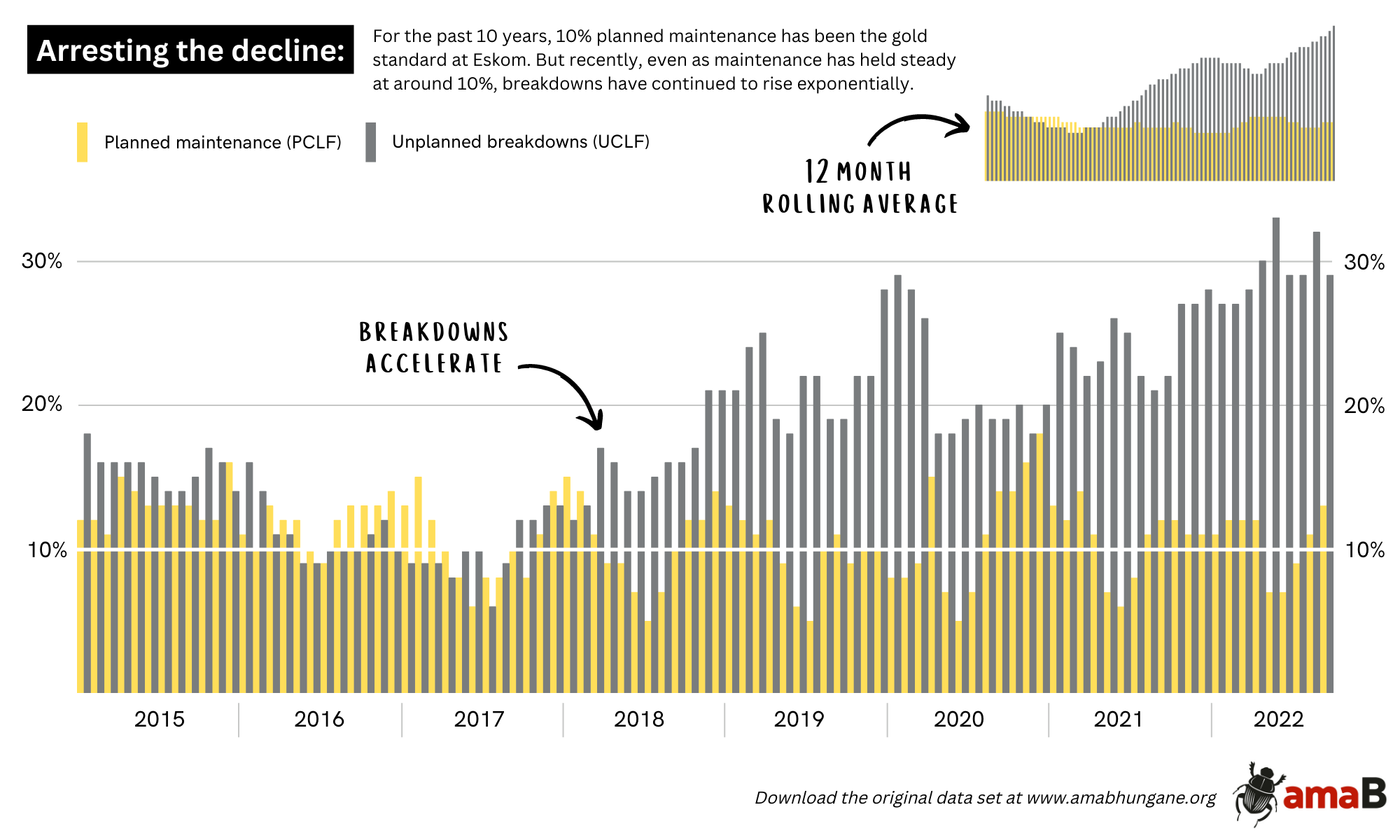


















 Become an Insider
Become an Insider
Very informative and well researched article
Excellent explanation of simplistic over optimism. One thing that Eskom and Government always ignore is the alternative of saving energy particularly during evening peak. Not only can homes save energy with solar water heating, if government allowed, the private sector could rapidly input additional MWH into the grid through rooftop solar. Both would rapidly contribute to relieving pressure on power needs.
Medupi and Kusile are brand new stations. If just those two were performing at design output, we would have no loadshedding. As to what must be done : Eskom should not be allowed to construct new generation. They made a total mess of Medupi and Kusile and Ingula pumped storage. What makes anybody think they will suddenly get better at projects? In its entire 75 year history Eskom has not built any project on time on budget. Why? Partly because they are way too clevererer and don’t do turnkey projects. Project risk should be handed to private sector.
Please call all the IPPs and ask them if they have been allowed to inject their extra power into the grid
Having spoken to 3 of them – there is somewhere between 5 and 10% that has an EIA plus is physically installed. The only detriment to this is contractual.